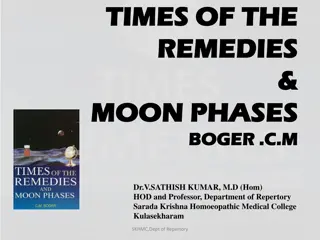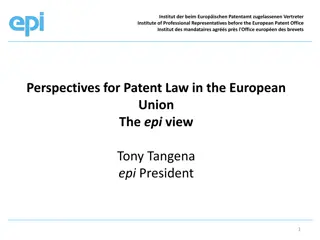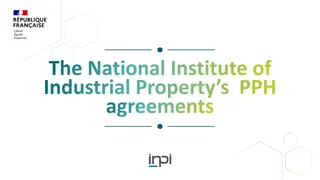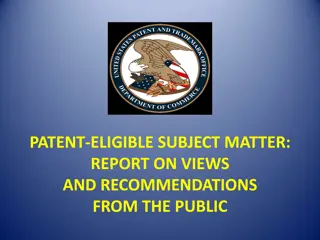Understanding Patent Infringement and Remedies in Legal Context
This special lecture series at National Law University Assam delves into the crucial topic of patent infringement and remedies. The lecture explores what constitutes infringement, relevant case laws, acts that do not amount to infringement, and remedies against infringement, covering both procedural and substantive aspects. Insights are provided by Prof. (Dr.) M. K. Bhandari, Dean School of Law at IMS Unison University, Dehradun.
Download Presentation

Please find below an Image/Link to download the presentation.
The content on the website is provided AS IS for your information and personal use only. It may not be sold, licensed, or shared on other websites without obtaining consent from the author. Download presentation by click this link. If you encounter any issues during the download, it is possible that the publisher has removed the file from their server.
E N D
Presentation Transcript
Special lecture series at National Law University Assam Greetings and Namaskar Lecture-2 INFRINGEMENT OF PATENT & REMEDIES Prof. (Dr.) M. K. Bhandari Dean School of Law Director International Initiatives and Research IMS Unison University Dehradun Email- dean.sol@iuu.ac
What constitutes Infringement Patent Holder or his assignee alone have right to use/exploit patent. Any unauthorised use of patent amounts to infringement. Forms of Infringement: Colourable imitation of patented invention. Material variation in the invention. Mechanical equivalent in the invention. Taking essential features in the invention.
Relevant Case Laws Lallubhai Chakubhai JariwalavsChimanlal & Co [AIR 1936 Bom99] Dudgeon vsThomson (1877) [3APP Case 34] Laxmi DuttRoopChand vs Nanku & Ors [AIR 64 AII 27] Doctrine of Pith and Marrow If Pith and Marrow of invention (which is essence) is taken and reproduced in Infringement article , it can be presumed that infringement has takenplace.
Acts which do not amount to infringement (Sections 47 & 107-A) Following acts shall not be considered as an act of Infringement: i. Import of any machine apparatus or other articles (of which patent is granted) by or on behalf of government. ii. Manufacturing or use of patented process by or on behalf of government iii. Manufacturing or use of patented articles or patented process by any person for the purpose merely of experimentation or research including imparting instruction to pupils.
i. Import of patented drug or medicines by the government for the purpose merely for its own use or for distribution in any hospital or dispensary or medical institution run or maintained by government. Any act of making, constructing, using, selling or importing a patented invention solely for uses reasonably related to the development and submission of information required to the development and submission of information required under any law for the time being in force, in India, or in a country other than India, that regulates the manufacture, construction, use, sale or import of any product. iii. Importation of patented products by any person from a person who is duly authorised by the patentee to produce, sell or distribute the product. ii.
Remedies Against Infringement Procedural Aspect Substantive Remedies Procedural Jurisdiction [section 104]- Suit for infringement instituted in district court having jurisdiction however when counter claim of revocation is made by defendant, suit shall be transferred to high court.[section 64]
Who can sue a) The patentee, including co- owner of patent. b) The exclusive licence if the licence is registered. c) A compulsory licensee when patentee refuses or neglects to institute proceedings. d) A licensee other than the above two licensees can bring an action for infringement depending upon the terms of the contract, between the licenser and the licensee. e) Assignee, he can sue only after the application for registration of the assignment in his favour has been filed . If a patent is assigned after the commencement of action, the assignee is to be joined as co- plaintiff. An assignee cannot sue for infringement which occurred prior to the assignment.
Burden of proof Generally it is on plaintiff, but where subject matter of patent is a process for obtaining a product-the court may direct defendant to proof. Period of limitation: 3 years from date of infringement. No requirement of notice.
Defences which may be raised by the defendant Revocation sec. 64. unlawful condition. Innocent infringement. Lapse of patent for want of renewal. Relevant cases: CadilaPhramaceutical Ltd V. Instacare 2001 PTC472(Guj) Fabcon V. Industrial Engeenering Coporation Air 1987 All. 338
SUBSTANTIVE REMEDIES INJUNCTION INTERLOCUTORY AND FINAL DAMAGES OR ACCOUNTS FOR PROFIT DELIVERY UP OR DESTRUCTION OF INFRINGING GOODS CERTIFICATE OF VALIDITY
CASE LAW: 1. National Research and Development Corporation vs. Delhi Cloths & General Mills AIR 1980 DEL 132(Principles for grant of injunction laid down). 2. CadilaPharmaceutical v. Instacare lab. 2001 ptc 472(no prima facia evidence of valid patent found). 3.M.C Jayasingh v. Mishra Dhatu Nigam(2009)(patent endorsed with licence or right ;no final injunction can be granted). 4.Bajaj Auto v. TVS Motor Co.(2008) (certificate of validity)
GROUNDLESS THREAT OF INFRINGEMENT PROCEEDINGS- (SECTION -106) SUIT ANGAINST PERSON WHO MAKES GROUNDLESS THREAT.























